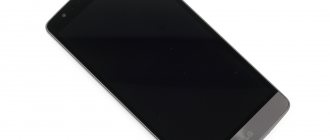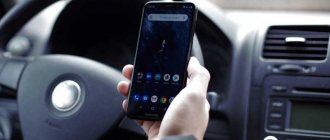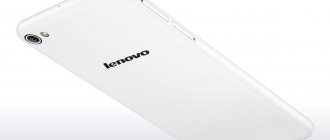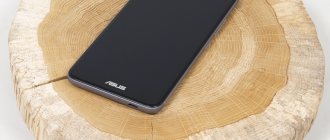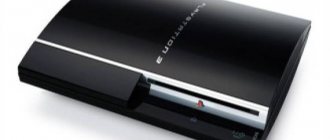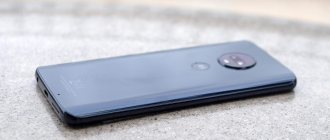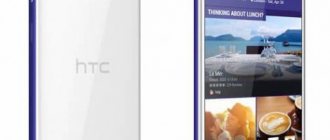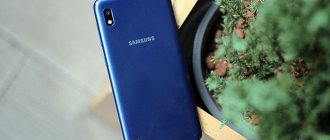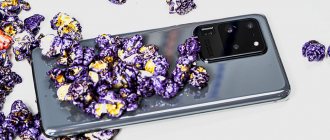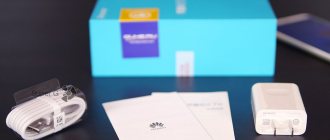Design
The most important and important component of a smartphone is its appearance. The G4 looks very good, fits perfectly in the hand, pleases with the genuine leather on the back cover and brings extremely positive emotions from its use.
The software shell, coupled with the ergonomics of the case, makes the smartphone feel like home after just a couple of hours of use.
You take a new product out of your pocket, and it feels like you’ve been using it for several months. However, I in no way want to say that the design of the device quickly becomes boring. Here everything is just the opposite.
G4 emblem on leather cover
The front side is slightly curved and this is a feature that is characteristic of all the company’s new smartphones: from Leon to the hero of today’s review .
The protective glass on the front panel perfectly protects the screen from fingerprints and dust. A must have for any modern device.
The back side is a different story. First, let's talk about the trim levels. In our country, the device will be sold in five variations. Firstly, there are three models available with leather trim: light brown, black and red.
Initially, at the pre-order stage, you can choose only from two options: with light brown or black leather on the back. The most interesting thing is, of course, the bright colors of the skin. However, the black lid also looks quite good. The red shade will appeal to the female half of humanity. The texture of the skin varies from model to model, but to the touch it is slightly dry - the surface, so to speak, is far from glossy. I am not an expert in this area, so I say what I see and feel.
Later, two more models will be available: with a white or dark gray plastic back cover.
The first creates a strong feeling that the lid is made of ceramic. The protruding edges play interestingly in the light and even convey the coolness that is characteristic of real ceramics.
The downside here is that the appearance of such a cover quickly deteriorates. Even on demo samples, at a certain lighting angle, scratches were clearly visible, which spoil the appearance of the device.
Scratched surface of white LG G4
The latest modification is a dark gray model with an imitation of specially processed metal. An analogue of what we already saw in its predecessor - G3. It doesn’t bring any positive experience, it’s just a lid, just plastic - in general, compared to other modifications, this one looks boring.
Personally, I would choose between a light brown or a black leather model. The first option looks stylish and bright, the second is restrained and noble. In any case, the presence of leather pleasantly warms the soul and gives the feeling that 40,000 rubles were not given in vain. By the way, the remaining colors of the skin (turquoise, bright yellow, light gray), as well as the additional gold color of the plastic cover, will not be sold here, and indeed will appear on sale around the world a little later.
If you are in Europe or South Korea, take a device with such a cover there. Of the modifications that are not available on our market, I liked the most, as I already said, the turquoise color. Not a boy's option, but girls will be delighted.
The dimensions of the device can be assessed in comparison with its competitors using the table below.
| Length | Width | Thickness | Weight | |
| LG G4 (5.5'') | 148,9 | 76,2 | 9,8 | 155 |
| LG G3 (5.5'') | 146,3 | 74,6 | 8,9 | 149 |
| Apple iPhone 6 Plus (5.5'') | 158,1 | 77,8 | 7,1 | 172 |
| Xiaomi Mi Note Pro (5.7'') | 155,1 | 77,6 | 7 | 161 |
| Samsung GALAXY Note 4 (5.7'') | 153,5 | 78,6 | 8,5 | 176 |
As before, the new product will have its own cases available with the familiar round window on the front. You can use many applications without opening the case: listen to music, take pictures, answer calls, and so on.
The back cover of the case fits very tightly to the body of the smartphone, so the accessory does not make the device much thicker. This is definitely a plus.
The control buttons, as has already happened within the company’s product line, are moved back. Their design, of course, has undergone changes, but this has not affected the convenience in any negative way. As before, operating a smartphone is convenient.
By carefully separating the battery compartment cover from the body, you can study in detail how this leather insert is glued, which takes about 12 weeks to create. It's simple. The skin layer is glued directly onto the plastic cover, and the protruding edges are neatly trimmed. If desired, the glued layer can be pryed off and probably even torn off from the plastic. It is unlikely that this can happen naturally during normal operation of the device.
But the skin can easily wear out over time and, perhaps, in just a few months you will receive a smartphone with a cover riddled with scratches.
In the photo above I tried to reflect one of the scratches that appeared on the back cover. It’s not noticeable, but if you look closely, the wear is noticeable. I wonder how LG is going to deal with users who will make complaints about the quality of the leather coating and is it going to do it at all? In general, time will tell and perhaps an interesting precedent will be created.
Display
The smartphone has a 5.5-inch diagonal screen with QuadHD resolution (2560 x 1440 pixels). The dot density is the same 538 ppi we are familiar with from the G3. The differences lie in technology. In its latest device, the manufacturer used a display built using Quantumm IPS (In-Cell touch) technology, which led to an improvement in color reproduction by 20%, an increase in brightness by 25%, and contrast by 50%.
In practice, the display is good in almost every way. In the sun it behaves well even in direct sunlight.
The viewing angles are excellent, but the black color is still not as deep as in the same Meizu MX4 Pro (on the right or top in the photo). The difference is noticeable only in direct comparison, but in reality it is not worth attaching importance to. At least for most users.
Hardware platform and performance
Despite the fact that the emphasis during the development of the LG G4 was placed mainly on its extraordinary appearance, it was not deprived of hardware either. The smartphone is built on the latest SoC Snapdragon 808 from Qualcomm, which includes 3 GB of RAM, 32 GB flash storage and an Adreno 418 video accelerator. This did not entail the abandonment of memory cards, which is why there is a lack of space for storing movies, games, photos and the user is unlikely to feel the music.
The test results are quite revealing. It is difficult to classify the LG G4 as a clear performance leader, but this is in direct comparison with the flagships of other companies. In real life, the interface literally flies, and the speed of the latest resource-intensive games once again proves that fans of mobile gaming no longer need to buy a separate console.
Full Specifications of LG G4
I wrote all this material based on the results of testing the LG-F500L model with one SIM card (version for South Korea). We will sell the LG G4 H818P model with support for two SIM cards simultaneously. Accordingly, the camera test and performance results are relevant for a smartphone, which in fact may not have the final firmware version, and therefore may not have indicators that are not sufficiently objective for the end consumer. However, let's start by comparing the characteristics of these two models according to the table below (changes are highlighted in green):
| LG G3 (D855) | LG G4 (H818P) | |
| CPU | Qualcomm Snapdragon 801 2.5 GHz (4 Krait 400 cores) | Qualcomm Snapdragon 808 1.8 GHz (6 cores, 64 bit, Cortex-A53 and Cortex-A57) |
| Video accelerator | Adreno 330 | Adreno 418 |
| RAM | 2 GB (3 GB versions available) | 3 GB |
| Built-in memory | 16 (versions with 32 GB available) | 32 GB |
| Memory card support | Yes (Micro SD up to 128 GB) | Yes (Micro SD up to 128 GB) |
| Display | 5.5'', IPS+, 2560 x 1440 pixels (538 ppi) | 5.5'', Quantumm IPS, 2560 x 1440 pixels (538 ppi) |
| Main camera | 13 MP (f/ 2.4, sensor size 1/3.06'') | 16 MP (f/ 1.8, sensor size 1/2.6'') |
| Front-camera | 2.1 MP | 8 MP (f/ 2.0) |
| Battery | 3000 mAh | 3000 mAh |
| OS | Android OS 4.4.2 (5.0 available for download) | OS Android 5.1 Lollipop |
| cellular | 2G, 3G, 4G | 2G, 3G, 4G (Cat 6) |
| Wireless interfaces | Wi-Fi (802.11 a/b/g/n/ac), Bluetooth 4.0, NFC, GPS, GLONASS, IR port | Wi-Fi (802.11 a/b/g/n/ac), Bluetooth 4.1, NFC, GPS, GLONASS, IR port |
| Connectors | USB 2.0 (OTG), 3.5 mm audio output | USB 2.0 (OTG), 3.5 mm audio output |
| Sensors | Accelerometer, digital compass, light sensor and distance sensor | Accelerometer, gyroscope, digital compass, light sensor, distance sensor |
| SIM card form factor | Micro | Micro (2x) |
| Water and dust protection | No | No |
We can’t help but be glad that the company has provided us with a dual-SIM option.
In Russia, people are practical: they use one SIM card for work, another for home, or calls and the Internet - an option for thrifty, practical citizens who, nevertheless, have an extra 43 thousand for a smartphone. Honored +1.
Review of Android smartphone LG G4s (H736): more balanced than the flagship
Table of contents
- Introduction
- Specifications
- Packaging and equipment
- Appearance and design
- Display
- Hardware platform and performance
- Software and firmware
- Multimedia
- Wireless Interfaces and Communications
- File system
- Battery life
- Camera
- Comparison with competitors
- Conclusion
- Additional photo examples
Introduction
It has become a tradition for many smartphone manufacturers to release compact versions of flagships.
And since the LG G2 mini and LG G3s previously passed through the laboratory,... ... one gets the feeling that the manufacturer himself diligently reads our (and not only) reviews about his models. In the case of the LG G2 mini, we complained that the model name did not really correspond to the “content”, and as if by magic, the “mini” prefix was abandoned in the next version.
The successor in the form of the LG G3s seemed to be a more logical and neat model, but still contained too weak a filling to carry even the conditional status of the “younger brother” of the flagship solution of that time, the LG G3.
Now we have LG G4s - a logical continuation of the line of compact premium smartphones.
announcements and advertising
2080 Super Gigabyte Gaming OC for 60 rubles.
Compeo.ru - the right comp store without any tricks
RTX 2060 becomes cheaper before the arrival of 3xxx
Ryzen 4000
series included in computers already in Citylink
The price of MSI RTX 2070 has collapsed after the announcement of RTX 3xxx
Core i9 10 series is half the price of the same 9 series
The price of memory has been halved in Regard - it’s more expensive everywhere
Specifications LG G4s
| Device type | Smartphone | Smartphone |
| Model | LG G4s | LG G3s |
| CPU | Qualcomm Snapdragon 615, 8 x 1460 MHz, Cortex-A53 | Qualcomm Snapdragon 400, 4 x 1200 MHz, Cortex-A7 |
| Video processor | Adreno 405 | Adreno 305 |
| operating system | Android 5.1 | Android 4.4.2 (5.1) |
| RAM, GB | 1.5 | 1.0 |
| Internal memory, GB | 8 | 8 |
| Screen | 5.2″ Full HD (1920 x 1080) | 5.0″ HD (1280 x 720) |
| Cameras, Mpix | 8.0 + 5.0 | 8.0 + 1.3 |
| Net | GSM 850/900/1800/1900 | GSM 850/900/1800/1900 |
| Number of SIM cards, pcs. | 2 | 2 |
| MicroSD support | Eat | Eat |
| Data transfer | Wi-Fi, WAP, GPRS, EDGE, NFC, HSDPA, 3G, LTE | Wi-Fi, WAP, GPRS, EDGE, NFC, HSDPA, 3G, (LTE - in some versions) |
| aGPS/GPS/GLONASS/Beidou | Yes/Is/Is/No | Yes/Is/Is/No |
| Battery, mAh | 2 210 | 2 540 |
| Dimensions, mm | 143.0 x 73.0 x 10.0 | 138.0 x 70.0 x 10.0 |
| Weight, g | 139 | 134 |
| price, rub. | ~17 000 / ~20 000 | ~12 000 / ~14 000 |
In terms of characteristics, there is a clear step forward - the manufacturer chose a single-chip system of a higher class (they could have installed QSD 410/412/415), increased the amount of RAM to a morally sufficient 1.5 GB and installed a clearer Full HD display.
Despite all this, the functionality has not been affected; the user still has access to two SIM card slots and a memory card slot. One can only complain about the reduced battery capacity, because the number of processor cores has doubled, and the screen resolution is now respectable.
Packaging and equipment LG G4s
Alas, as is usually the case with LG test samples, the review hero was deprived of all packaging and accessories. But since this is still not a flagship model, we can hardly expect a rich set.
Most likely, the list of accessories will be as follows:
- Charger;
- MicroUSB cable;
- Documentation.
It is known that the manufacturer will offer a branded Quick Circle case.
Appearance and design of LG G4s
A trained eye will immediately calculate the proportions characteristic of LG smartphones; similar curves of the upper and lower sides of the device have been familiar to us since the days of the LG Nexus 5.
The non-standard arrangement of buttons on the back side remained untouched; apparently, users liked it, and I can’t say anything objectively bad about such a design move.
The design of the case is collapsible, the batteries are removable. The panels are made entirely of plastic, which imitates metal, although when touched, the state of affairs immediately becomes obvious.
There are other color options, including the recently fashionable golden.
So as not to bore you, I’ll tell you right away - the display is curved. But not much. LG can't just bend the screen of a smartphone. But I don’t see anything wrong with this, the bend is barely noticeable and does not interfere with comfortable operation of the device, as was the case with the LG G4.
Since the physical keys are located on the back of the smartphone, the side ends are left without meaning.
The location of the MicroUSB port and AUX output is classic, the charger cord is connected at the bottom, and the headphones are connected at the top.
On the test sample, at one of the corners, the back cover did not fit tightly to the body and was “asking for porridge,” but this is not surprising, because this is a test sample that is not for sale. Otherwise, the quality of manufacturing and processing of materials does not raise any questions. The only interesting thing is how the back cover will look if it is deeply scratched.
The ringing speaker is not equipped with any protection against muting, but it is not needed, since the smartphone body is curved.
There is nothing unusual from the front side. Light and proximity sensors work correctly, brightness changes smoothly, adaptive brightness changes work well.
The model is not deprived of an LED event indicator, which is located in the corner of the case and has adequate brightness and wide viewing angles.
The build quality of the front camera module is good, the lenses are of medium size, and no coating defects were found.
And here is the keyboard module itself. When you remove the cover, it remains in place. The build quality is good, the gaps are minimal.
Following fashion trends, the LG G4s has a dual LED flash, which is designed to eliminate the excessively cold cast when shooting portraits. The only alarming thing is that the reflector on top of the first LED is too simple. To the left of the lenses is an IR sensor, which is supposed to measure the “color spectrum”. The manufacturer himself provides the following information:
“A true work of art, the infrared color sensor designed for the LG G4s automatically analyzes and measures all shades of color before taking a photo, ensuring natural and accurate reproduction of the smallest details and tones, even in low-light conditions.”
It sounds good, but we will find out how it works and whether it works at all in the appropriate section.
The lenses of the rear module are of medium size; subtle inclusions are visible on their surface, similar to very fine dust.
“Under the hood” we will find a non-standard arrangement of elements. Thus, the slots for memory cards and SIM cards are located opposite each other, while one of them (pictured on the right) is double. Among the design flaws, I can note the insufficient number of latches on the back cover, and the NFC antenna contact area is not the most reliable - the contact “antennae” clearly pushes through the plates on the cover, which over time can lead to the loss of stable contact. Whether this will actually happen is a matter of time.
Overall, the LG G4s looks quite modern and stylish. Of course, it does not reach the chic of flagship models, but our hero does not pretend to be in this place. The frames around the display are quite thin, the body fits well in the hand, although it has a rather slippery back cover.
Performance
Everything is fine with this parameter. Or rather, everything will be fine with the release of more stable and debugged firmware. Now on the test device (see model above), the animation of desktops, menus and everything else slowed down from time to time. The problems are clearly of a software nature, which will most likely be fixed in the very near future. Again, LG understands everything, tries, and works to improve its products. The stability and speed of the G3 is further confirmation of this.
There are no problems in games. Dead Trigger 2 and Real Racing 3 did not sag even in dynamic scenes. As for system tests, the results are as follows.
We see that this year's Korean flagship is ahead of most of the top devices from 2014, but some of them (Samsung Galaxy Note 4 or Meizu MX4) were still too tough for it. It’s time to ask the question - what’s the matter? Especially if you remember the test result in AnTuTu on the Samsung Galaxy S6 Edge - more than 65 thousand points in a non-64-bit test.
Firstly, LG clearly does not use chemicals in the tests, unlike their Korean colleagues, and the device is tested in exactly the same mode as may be available to the user. There are clearly no additional accelerators provided. Secondly, we see that the company is shifting its focus from maximum performance characteristics and giving the user something different, perhaps even more important - design and user experience. The absolute leaders in the latter are, of course, the guys from Apple. The company creates a product that is far from top-end in terms of technical characteristics, but makes it (at least tries) as convenient as possible in communicating with the user.
And besides, the iPhone is fashionable, it’s status, and smartphones from Samsung or LG cannot yet boast the same charge. However, LG is still trying to do something similar and offer the user a comfortable device, and not the maximum hardware, which most users did not ask for.
The manufacturer is following its own path, although it is parallel to the game Apple is playing. Where and when these manufacturers will meet is a big question, the answer to which we will receive in the coming years, but not in the current time period and, unfortunately, not in the example of LG G4’s competition with the iPhone 6S. However, a start has been made and that’s great.
Reviews about LG G4 H818
Advantages:
After suffering with the Sony Xperia Z2 for more than a year, I finally decided to change to this device. And I didn’t regret it: -The tactile sensation (cover with brown leather) is simply fantastic. I bought myself an excellent genuine leather case for 35 euros from Latvia (I know, it’s expensive at today’s exchange rate... but it’s worth it, much more presentable than any Chinese items for a couple of bucks) - it looks rich. — The shape of the case and screen are excellent. Fits perfectly in the hand. Ergonomics are excellent. — Excellent bright high-resolution screen. — CAMERA. This is what makes this device worth buying. Night (!) photographs come out excellent, daytime ones without question. Someone complains that the flash turns green, I don’t know, I haven’t checked it yet. The front camera is also excellent (on par with my Z2's main camera). -Telephone part without questions. Working with 2 SIM cards is organized very competently. -The interface works smoothly, but microlags are still present in some third-party programs (vk, tinder). -I won’t write anything about the filling and interfaces. It's a complete mess today. Special thanks for the ability to control equipment via an infrared port and a removable SD card. -The assembly is good (nothing loose or creaks)
Flaws:
They are. But not too significant: -The most important. BATTERY. The problem with all modern flagships. Having run it for the first time under medium load, I was shocked that by 2 o’clock in the afternoon there was less than half of the battery left (if removed from the cord at 7 am). In this case, the screen was used for less than an hour, i.e. Something was eating up the battery in the background. Partially managed to solve (see below). -The sound in the headphones is average. Although I wouldn’t say it’s completely bad, no, you can listen to it. But in Z2 it was better, but here the same bass is somehow “dirty”. Although perhaps it seems to me. By the way, I ordered my own Quadbeat 3 headset from Korea, we’ll see what happens with it. -The light sensor does not work very correctly; in the dark it turns the screen brightness to zero. You take your phone out of its case when there is an incoming call, but it thinks that it’s night and nothing is visible on the screen for the first few seconds. You have to turn off the auto-brightness adjustment, which noticeably increases battery consumption. I hope they will fix it in future firmware.
A comment:
The increased battery consumption in standby mode was partially resolved as follows: 1. Disabling all unused interfaces (including the “economical” geolocation mode, in my case this was key). 2. Removing all unnecessary programs (LG Health Pedometer, Smart Bulletin, all sorts of live wallpapers, etc.) 3. Disabling Fast dormancy mode ( 277634#*# call button -> Field Test -> Modem settings -> PDP Setting -> (0 ) Set LG Fast Dormancy - set the value to ON). Here opinions on the forums differ, but it seemed to me that if you turn it off, the battery consumption decreases somewhat. Having done all this, and also pumped the battery with full charge-discharge cycles several times, we managed to get a full day and a half of work, the screen works for up to three hours. In this case, I don’t turn off LTE at all, the only exception is switching to Wi-Fi where it is available. If LTE had been turned off, I think 4 hours of screen time could have been squeezed out. But this is quite enough. And I’m still thinking about buying a second battery, because when the screen is on, the battery percentage drains right before my eyes. And so in terms of price-quality ratio for a modern flagship (taking into account the current exchange rate) it’s quite worthy, I recommend it for purchase. If only because of the excellent camera.
Camera
The front photo module has grown to 8 megapixels and acquired a fairly large aperture ratio of f/ 2.0. As before, various gestures are available for remote photo control (releasing the shutter by clenching your palm into a fist), but now the arsenal of seasoned selfies has been expanded with the ability to take up to 4 frames in a row with different faces. Later you can choose the best one or leave all the pictures at once.
You can describe the main camera in a few words as follows: everything is very cool, but I expected more.
A year ago, with the release, the company set the bar for itself and its competitors. The device took pictures, and now it takes pictures perfectly well. There is a drop in night shots compared to competitors, but it is not critical.
What has changed now? Yes, in general, nothing. The camera capabilities have been improved, the algorithms have been optimized, but nothing radically new has been shown. We'll talk in detail about the camera's capabilities in a full review of LG G4 , but for now here's what was announced by the manufacturer.
The matrix has increased and now its dimensions are 1/2.6''. The installed lens received a constant aperture value of f/ 1.8. The stabilization function (OIS 2.0) has also been improved: now the picture is aligned along all three axes (X, Y, Z). The focusing speed has not changed compared to the G3 and is still the same 0.27 seconds, and an infrared light spectrum sensor specially installed next to the camera is responsible for correct color reproduction. Yes, as it turns out, this is not a dual LED flash.
The G4 shoots better than most of last year's flagships, but it doesn't compare to the camera in the Galaxy S6 Edge. The latter is good on all fronts and it will not be easy for its future competitors of this year, which have not yet been announced, to compete with it.
Examples of frames taken on the G4 in comparison with the Meizu MX4 Pro (right) that was at hand are below.
The originals of all the photographs presented above can be obtained from here.
Separately, it is worth mentioning the ability to take pictures in RAW format (without compression) and completely customize the shooting process: control manual focus, select the desired ISO value, set the shutter speed to 30 seconds, and so on.
The smartphone is capable of recording video in Full HD resolution (up to 60 fps) or Ultra HD (3840 x 2160 pixels) at 30 frames per second. The device copes with this quite well, however, an example of the corresponding video is below (don’t forget to set the appropriate resolution when viewing).
LG G4 camera in action
16 megapixel sensor
f/1.8 aperture
Matrix with crop factor 1/2.6
3-axis optical stabilization system
LED flash and fast laser autofocus
Battery life
The short time during which I was able to test the device is certainly not enough to make a full conclusion regarding the autonomy of the device. However, some results can be drawn now.
LG G4 will work for a day at best.
With active use, the device is unlikely to survive until dark (we're talking about summer). You will have to charge the device every day; you most likely cannot expect anything different.
As soon as I have the opportunity to test the smartphone for a longer period of time, I will report more detailed results, but for now we’ll focus on this. It's summer now, sunshine, warm water for swimming and green parks here and there. Why not put down your smartphone (let it be a G4 or something else) for a while and go, for example, for a walk in the fresh air, leaving all your electronic gizmos at home? This will clearly be more useful than collecting an extra hundred likes on Instagram and burning milliamps per hour on your smartphone. Manufacturers involuntarily hint at this to us.
LG G4 video review
But what I like about LG: unlike some other companies, it doesn’t try to copy anyone in at least some way. Yes, in 2010-2012 we saw quite a few smartphones that resembled (to be honest) Samsung. And both externally and in software. Now I look at the new G4 and understand that other companies will copy it. In general, I don’t understand when big companies openly copy ideas from others, it kind of turns me off. Borrowing is ok, but not plagiarism.
